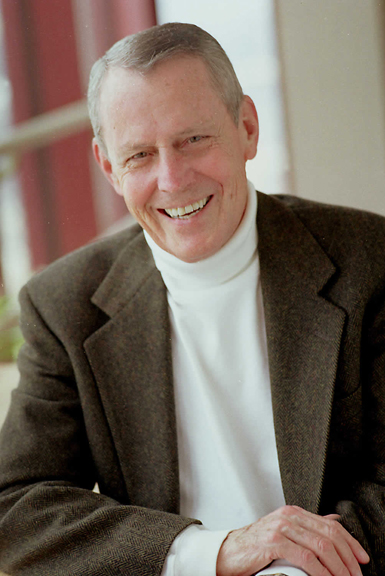Pitt’s Starzl Receives 2012 Lasker Award
 Thomas E. Starzl, Distinguished Service Professor of Surgery at the University of Pittsburgh, has been named a recipient of the 2012 Lasker~DeBakey Clinical Medical Research Award for his pioneering work in the field of liver transplantation, an achievement that, in the words of the Albert and Mary Lasker Foundation, “most physicians deemed an impossible dream.”
Thomas E. Starzl, Distinguished Service Professor of Surgery at the University of Pittsburgh, has been named a recipient of the 2012 Lasker~DeBakey Clinical Medical Research Award for his pioneering work in the field of liver transplantation, an achievement that, in the words of the Albert and Mary Lasker Foundation, “most physicians deemed an impossible dream.”
Considered by many to be the “Father of Transplantation,” Starzl performed the first successful liver transplantation in 1967. In subsequent decades, he trained a generation of surgeons to do the operation, mentoring emerging physician-scientists in a quest to unravel the intertwined complexities of biomolecular factors, immunology, infection control, and pharmacology, eventually applied in human clinical trials. He is credited with evolving kidney transplantation into an effective procedure, and performed the first heart-liver transplant in 1984. He also introduced four commonly used immunosuppressive drugs for clinical transplantation, establishing a foundation for successful immune-system management and drug-regimen strategies in the transplantation of all kinds of organs. The discovery in 1992 by Starzl and colleagues of donor white blood cells in the tissues of long-term functioning organ transplant recipients unmasked a fundamental principle of transplantation tolerance, and he has sought advances in understanding antigens, which govern immunologic responsiveness.
“Dr. Starzl has built an unparalleled record of impact as a uniquely gifted surgeon, a visionary researcher, a prolific scholar, and an influential teacher in the groundbreaking and life-saving field of organ transplantation,” said Pitt Chancellor Mark A. Nordenberg. “He has devoted his life to advancing the cause of human heath, and his exceptional contributions have made him a hero to countless transplant recipients, their doctors, and their families. Dr. Starzl also played a major role in the transformation of the Pittsburgh region into a world-class center of pioneering medical research, cutting-edge health sciences education, and the highest quality health care. He is a beloved and inspiring member of the University of Pittsburgh family, and we extend our most sincere congratulations to him.”
According to Arthur S. Levine, senior vice chancellor for the health sciences and dean, Pitt’s School of Medicine, “Dr. Starzl is without a doubt one of the legendary figures in medicine and surgery. His contributions to biomedical science and the treatment of liver and metabolic diseases are truly extraordinary.”
“I am deeply honored to be acknowledged by the Lasker Foundation,” Starzl said. “Liver transplantation and our expanding knowledge of the workings of immunological tolerance have helped save the lives of countless people, and it is immensely gratifying to have played a role in these efforts.”
Starzl joined the University of Pittsburgh School of Medicine in 1981 as a professor of surgery. In the early ‘80s, he showed that cyclosporine treatment increased the success rate of liver, kidney, and heart transplantation, and opened up the possibility of lung and pancreas transplantation. He began exploring in 1986 the value of another anti-rejection drug called FK506, or tacrolimus, which further improved survival rates and made intestinal transplant a reality. In 1992 and 1993, Starzl’s team made medical history when surgeons performed two baboon-to-human liver transplants.
In 1996, the University of Pittsburgh Transplantation Institute, which Starzl directed for many years, was renamed in his honor, as was Pitt’s Biomedical Science Tower in 2006 on the occasion of his 80th birthday. In 2004, Starzl received the National Medal of Science, the nation’s highest scientific honor. He retired from clinical practice in 1991.
The prize, which includes a shared honorarium of $250,000, will be awarded by the Lasker Foundation on Sept. 21 in New York City. The Lasker Awards are given in four categories—basic medical research, clinical medical research, public service, and special achievement in medical science—to honor scientists who change the world in ways that save lives and benefit society. The awards are sometimes characterized as the American Nobels, because 81 Lasker laureates have gone on to win a Nobel Prize.
Starzl shares the prestigious prize with Roy Calne, emeritus professor, University of Cambridge, who began Europe’s first liver transplantation program in 1968. Calne extensively researched anti-rejection drugs including azathioprine, cyclosporin A, and rapamycin in the process of making it possible to transplant donor organs.
Starzl and Calne “persevered on a bold course against a backdrop of doubt,” the Lasker Foundation noted. “By following glints of hope, they have brought new life to thousands of individuals.”
Other University of Pittsburgh winners of Lasker Awards include faculty member the late Philip Hench in 1949, who won the Nobel Prize in Physiology or Medicine in 1950; faculty member the late Jonas Salk in 1956; alumnus Herbert W. Boyer (A&S '60G, '63G) in 1980; alumnus the late Paul Lauterbur (A&S '62G) in 1984, who won the Nobel Prize in Physiology or Medicine in 2003; and emeritus professor and alumnus Bernard Fisher (A&S '40, MED '43) in 1985.
Founded in 1942, The Albert and Mary Lasker Foundation fosters the prevention and treatment of disease and disabilities by honoring excellence in basic and clinical science, by educating the public, and by advocating for support of medical research. Additional information on the foundation is available at www.laskerfoundation.org.
Other Stories From This Issue
On the Freedom Road

Follow a group of Pitt students on the Returning to the Roots of Civil Rights bus tour, a nine-day, 2,300-mile journey crisscrossing five states.
Day 1: The Awakening
Day 2: Deep Impressions
Day 3: Music, Montgomery, and More
Day 4: Looking Back, Looking Forward
Day 5: Learning to Remember
Day 6: The Mountaintop
Day 7: Slavery and Beyond
Day 8: Lessons to Bring Home
Day 9: Final Lessons

